语言学概论复习资料
语言学概论复习资料
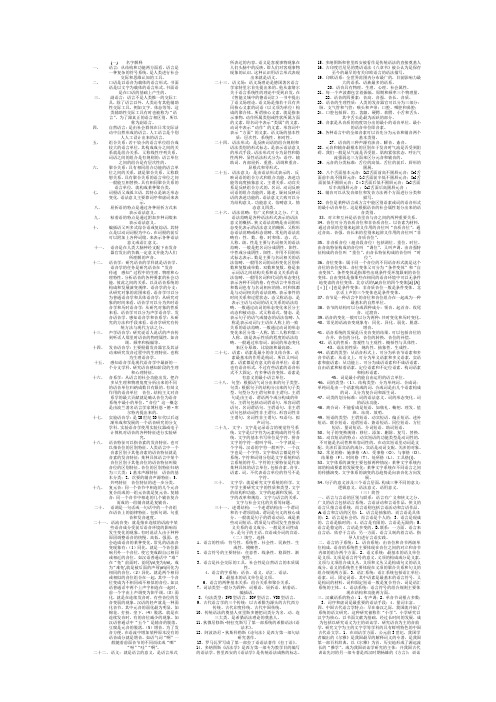
(一)名字解释一、语言:从结构和功能两方面看,语言是一种复杂的符号系统,是人类进行社会交际和思维认知的工具。
二、口语是以语音为载体的语言形式,书面语是以文字为载体的语言形式。
书面语是在口语的基础上产生的。
三、副语言:语言不是人类惟一的交际工具,除了语言以外,人类还有其他辅助性交际工具,例如文字、体态等等,这类辅助性交际工具有时也被称为“语言”,为了跟真正的语言相区别,所以称为副语言。
四、自然语言:是由社会群体在日常交际活动中自然形成的语言,人工语言是个别人人工设计出来的语言。
五、组合关系:若干较小的语言单位组合成较大的语言单位,其构成成分之间的关系就是组合关系,又称线性序列关系。
词语之间的组合是有规则的;语言单位之间的组合是有层次性的。
六、聚合关系:具有相同组合功能的语言单位之间的关系,就是聚合关系,又称联想关系。
具有聚合关系的语言单位之间一般能互相替换。
具有相同聚合关系的语言单位,就构成某种聚合类。
七、词根语又成孤立语,其特点是缺乏形态变化,语法意义主要靠词序和虚词来表示。
八、屈折语的特点是通过各种屈折方式来表示语法意义。
九、粘着语的特点是通过附加多种词缀来表示语法意义。
十、编插语又叫多式综合语或复综语,其特点是以动词词根为中心,在词根的前后可以附加上各种词缀,来表示各种语法意义或语汇意义。
十一、语音是在人类大脑神经支配下由发音器官发出的负载一定意义并能为人们所理解的声音。
十二、语音学:研究语音的学科就是语音学。
语音学的任务是研究语音在“发音---传递---感知”过程中的生理、物理和心理特性,分析语音的各种要素的社会功能,彼此之间的关系,以及语音系统的构成和发展演变规律。
语音学的分支:从研究对象的范围来看,语音学可以分为普通语音学和具体语音学;从研究对象的时间来看,语音学可以分为共时语音学和历时语音学;从研究对象的性质来看,语音学可以分为声学语音学、发音语音学、感知语音学和音系学;从研究的方法和手段来看,语音学研究有传统方法与现代方法之分。
《语言学概论》知识点复习
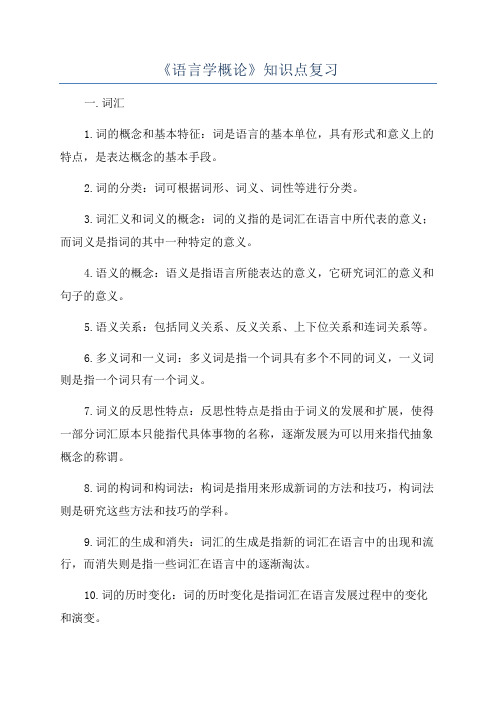
《语言学概论》知识点复习一.词汇1.词的概念和基本特征:词是语言的基本单位,具有形式和意义上的特点,是表达概念的基本手段。
2.词的分类:词可根据词形、词义、词性等进行分类。
3.词汇义和词义的概念:词的义指的是词汇在语言中所代表的意义;而词义是指词的其中一种特定的意义。
4.语义的概念:语义是指语言所能表达的意义,它研究词汇的意义和句子的意义。
5.语义关系:包括同义关系、反义关系、上下位关系和连词关系等。
6.多义词和一义词:多义词是指一个词具有多个不同的词义,一义词则是指一个词只有一个词义。
7.词义的反思性特点:反思性特点是指由于词义的发展和扩展,使得一部分词汇原本只能指代具体事物的名称,逐渐发展为可以用来指代抽象概念的称谓。
8.词的构词和构词法:构词是指用来形成新词的方法和技巧,构词法则是研究这些方法和技巧的学科。
9.词汇的生成和消失:词汇的生成是指新的词汇在语言中的出现和流行,而消失则是指一些词汇在语言中的逐渐淘汰。
10.词的历时变化:词的历时变化是指词汇在语言发展过程中的变化和演变。
二.语音1.语音的概念:语音是语言的基本要素之一,研究语言音素、音节和音系等内容。
2.音位和音素:音位指的是语音系统中不同的基本音单元,而音素则是指在一种具体语音系统中有决定意义的语音单位。
3.国际音标:国际音标是一种国际通用的音标符号,用于表示各种语言的语音。
4.声调:声调是指语音中声音的高低和音调变化。
5.语调:语调是指在一句话中语音音调的变化。
6.连读和重音:连读是指在语音流通的过程中,语音之间的相互作用和连接;重音是指在词语和句子中,一些音节能够产生的较大音量、较长时间和较高音调。
7.训练和修正:语音训练是指通过学习和练习,使得个体能够正确地使用语音来表达意义;语音修正是指对发音错误进行纠正和改正。
三.语法1.语法的概念:语法是语言结构和组织的规律和原则。
2.句子的基本概念:句子是表达完整意义的语言单位,由主语、谓语和宾语等成分组成。
语言学概论复习资料
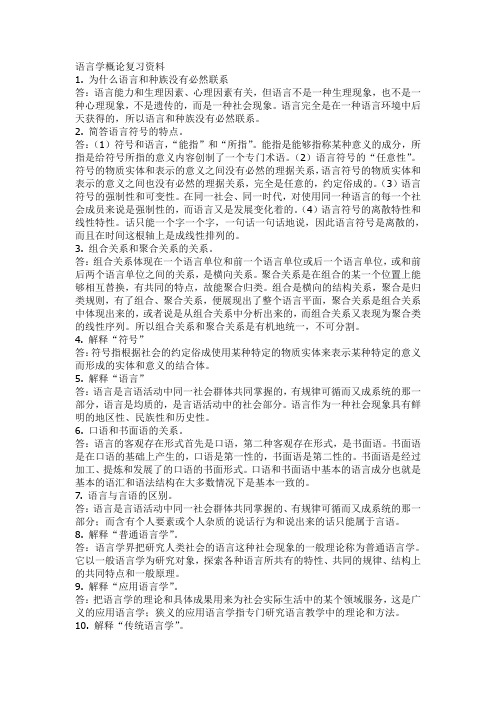
语言学概论复习资料1. 为什么语言和种族没有必然联系答:语言能力和生理因素、心理因素有关,但语言不是一种生理现象,也不是一种心理现象,不是遗传的,而是一种社会现象。
语言完全是在一种语言环境中后天获得的,所以语言和种族没有必然联系。
2. 简答语言符号的特点。
答:(1)符号和语言,“能指”和“所指”。
能指是能够指称某种意义的成分,所指是给符号所指的意义内容创制了一个专门术语。
(2)语言符号的“任意性”。
符号的物质实体和表示的意义之间没有必然的理据关系,语言符号的物质实体和表示的意义之间也没有必然的理据关系,完全是任意的,约定俗成的。
(3)语言符号的强制性和可变性。
在同一社会、同一时代,对使用同一种语言的每一个社会成员来说是强制性的,而语言又是发展变化着的。
(4)语言符号的离散特性和线性特性。
话只能一个字一个字,一句话一句话地说,因此语言符号是离散的,而且在时间这根轴上是成线性排列的。
3. 组合关系和聚合关系的关系。
答:组合关系体现在一个语言单位和前一个语言单位或后一个语言单位,或和前后两个语言单位之间的关系,是横向关系。
聚合关系是在组合的某一个位置上能够相互替换,有共同的特点,故能聚合归类。
组合是横向的结构关系,聚合是归类规则,有了组合、聚合关系,便展现出了整个语言平面,聚合关系是组合关系中体现出来的,或者说是从组合关系中分析出来的,而组合关系又表现为聚合类的线性序列。
所以组合关系和聚合关系是有机地统一,不可分割。
4. 解释“符号”答:符号指根据社会的约定俗成使用某种特定的物质实体来表示某种特定的意义而形成的实体和意义的结合体。
5. 解释“语言”答:语言是言语活动中同一社会群体共同掌握的,有规律可循而又成系统的那一部分,语言是均质的,是言语活动中的社会部分。
语言作为一种社会现象具有鲜明的地区性、民族性和历史性。
6. 口语和书面语的关系。
答:语言的客观存在形式首先是口语,第二种客观存在形式,是书面语。
《语言学概论》复习知识点——汇总
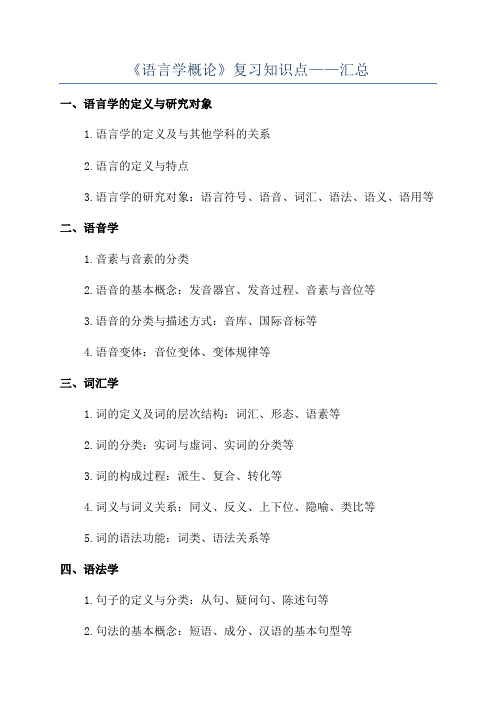
《语言学概论》复习知识点——汇总一、语言学的定义与研究对象1.语言学的定义及与其他学科的关系2.语言的定义与特点3.语言学的研究对象:语言符号、语音、词汇、语法、语义、语用等二、语音学1.音素与音素的分类2.语音的基本概念:发音器官、发音过程、音素与音位等3.语音的分类与描述方式:音库、国际音标等4.语音变体:音位变体、变体规律等三、词汇学1.词的定义及词的层次结构:词汇、形态、语素等2.词的分类:实词与虚词、实词的分类等3.词的构成过程:派生、复合、转化等4.词义与词义关系:同义、反义、上下位、隐喻、类比等5.词的语法功能:词类、语法关系等四、语法学1.句子的定义与分类:从句、疑问句、陈述句等2.句法的基本概念:短语、成分、汉语的基本句型等3.句法关系与句法结构:并列、从属、修饰等4.句法规则与句法分析:形式语法、语义角度的句法分析等5.语法现象的分析与解释:形式语法与功能语法的对比、语法规则、语法的普遍性、语法的可及性等五、语义学1.语义的定义与特点2.词义的构成与分类:词汇意义、语法意义、逻辑意义、上下文意义等3.语义关系与语义角色:同义、反义、上下位、隐喻、类比、关联等4.语义现象的分析与解释:语义成分的划分与关系、语义的可及性、语义的派生与转化等六、语用学1.语用学的定义与研究领域2.语言交际与语言交际行为:意图、目的、合作原则等3.言外之意与言外之行:言外之意的表示方式、言外之行的示例等4.语用现象的分析与解释:语言行为、语用规则、语用的多样性等七、语言学研究方法与分支学科1.语言学研究的方法论:描述性研究、实证研究等2.语言学的分支学科:应用语言学、对比语言学、历史语言学、社会语言学等3.参考书目和领域动态:《现代语言学导论》、《实用语义学》、《语法学》等这些都是《语言学概论》中的重要知识点,希望以上内容对您的复习有所帮助。
语言学概论期末复习重点
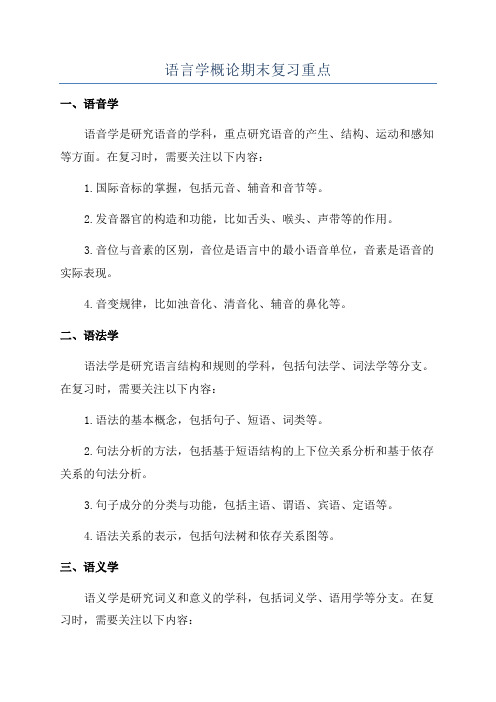
语言学概论期末复习重点一、语音学语音学是研究语音的学科,重点研究语音的产生、结构、运动和感知等方面。
在复习时,需要关注以下内容:1.国际音标的掌握,包括元音、辅音和音节等。
2.发音器官的构造和功能,比如舌头、喉头、声带等的作用。
3.音位与音素的区别,音位是语言中的最小语音单位,音素是语音的实际表现。
4.音变规律,比如浊音化、清音化、辅音的鼻化等。
二、语法学语法学是研究语言结构和规则的学科,包括句法学、词法学等分支。
在复习时,需要关注以下内容:1.语法的基本概念,包括句子、短语、词类等。
2.句法分析的方法,包括基于短语结构的上下位关系分析和基于依存关系的句法分析。
3.句子成分的分类与功能,包括主语、谓语、宾语、定语等。
4.语法关系的表示,包括句法树和依存关系图等。
三、语义学语义学是研究词义和意义的学科,包括词义学、语用学等分支。
在复习时,需要关注以下内容:1.语义的基本概念,包括词义、句义、语篇意义等。
2.词义的分类,包括编码词义和概念词义等。
3.语义关系的表示,包括隐性关系和显性关系等。
4.语义义原的掌握,比如用来描述词义的最小单位,可以用来解释多义、歧义、同义等现象。
四、语用学语用学是研究语言在特定情境中的使用和理解的学科,包括语用规则、言语行为等方面。
1.言语行为的分类,包括表示、指示、陈述、询问等。
2.言语行为的成分,包括言辞、语境、意图等。
3.语用规则的掌握,比如礼貌原则、言外之意等。
4.言语行为的实现方式,包括直接言语行为和间接言语行为等。
以上仅为语言学概论期末复习的一些重点内容,学生可以结合教材和课堂笔记进行更深入的学习和理解。
此外,复习时可以参考相关的案例和实例,加深对语言学原理的理解和应用。
语言学概论复习资料
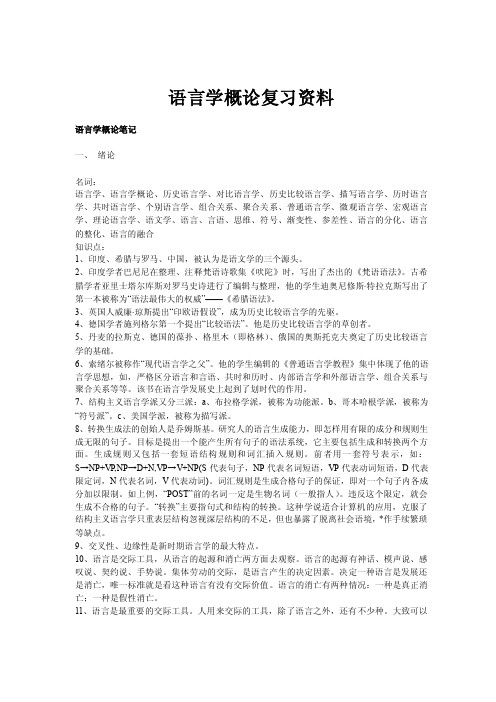
语言学概论复习资料语言学概论笔记一、绪论名词:语言学、语言学概论、历史语言学、对比语言学、历史比较语言学、描写语言学、历时语言学、共时语言学、个别语言学、组合关系、聚合关系、普通语言学、微观语言学、宏观语言学、理论语言学、语文学、语言、言语、思维、符号、渐变性、参差性、语言的分化、语言的整化、语言的融合知识点:1、印度、希腊与罗马、中国,被认为是语文学的三个源头。
2、印度学者巴尼尼在整理、注释梵语诗歌集《吠陀》时,写出了杰出的《梵语语法》。
古希腊学者亚里士塔尔库斯对罗马史诗进行了编辑与整理,他的学生迪奥尼修斯·特拉克斯写出了第一本被称为“语法最伟大的权威”——《希腊语法》。
3、英国人威廉·琼斯提出“印欧语假设”,成为历史比较语言学的先驱。
4、德国学者施列格尔第一个提出“比较语法”。
他是历史比较语言学的草创者。
5、丹麦的拉斯克、德国的葆扑、格里木(即格林)、俄国的奥斯托克夫奠定了历史比较语言学的基础。
6、索绪尔被称作“现代语言学之父”。
他的学生编辑的《普通语言学教程》集中体现了他的语言学思想,如,严格区分语言和言语、共时和历时、内部语言学和外部语言学、组合关系与聚合关系等等。
该书在语言学发展史上起到了划时代的作用。
7、结构主义语言学派又分三派:a、布拉格学派,被称为功能派。
b、哥本哈根学派,被称为“符号派”。
c、美国学派,被称为描写派。
8、转换生成法的创始人是乔姆斯基。
研究人的语言生成能力,即怎样用有限的成分和规则生成无限的句子。
目标是提出一个能产生所有句子的语法系统,它主要包括生成和转换两个方面。
生成规则又包括一套短语结构规则和词汇插入规则。
前者用一套符号表示,如:S→NP+VP,NP→D+N,VP→V+NP(S代表句子,NP代表名词短语,VP代表动词短语,D代表限定词,N代表名词,V代表动词)。
词汇规则是生成合格句子的保证,即对一个句子内各成分加以限制。
如上例,“POST”前的名词一定是生物名词(一般指人)。
《语言学概论》复习资料详细

《语⾔学概论》复习资料详细语⾔学概论第⼀章语⾔与语⾔学第⼀节绪论(语⾔学及其地位)语⾔学,顾名思义,是研究语⾔的科学。
语⾔是语⾔学的研究对象,所以,我们说,语⾔学是以语⾔作为专门研究对象的⼀门社会科学。
语⾔和⾔语的区分德·索绪尔(瑞⼠):20世纪最著名、影响最远的语⾔学家之⼀。
他的学说被誉为“哥⽩尼式的⾰命”,导致了欧美结构主义语⾔学派的诞⽣和发展,并使语⾔学成为⼀门真正独⽴的、⼗分专门的科学。
现代语⾔学的历史,正是从他这⾥开始的。
索绪尔被称为“现代语⾔学之⽗”;索绪尔在《普通语⾔学教程》中对语⾔和⾔语的区分作了系统的理论阐述。
其⽬的是为了纯化语⾔研究对象。
“语⾔”是说话所使⽤的⼀套符号系统;“⾔语”指说出来的话。
(语⾔和⾔语的关系:①抽象和具体的统⼀。
②⼀般和个别的统⼀。
③客观和主观的统⼀。
④稳定性和灵活性的统⼀。
)两者之间的联系(索绪尔称为的“第⼀个⼗字路⼝”)第⼀,没有⾔语就没有语⾔。
⾔语是第⼀性的,语⾔是第⼆性的。
第⼆,语⾔来源于⾔语⼜反作⽤于⾔语,起着决定性的规范作⽤。
区分的意义⾸先,它使语⾔的研究精确了范围;其次,对语⾔学习具有指导意义。
再则,知道了这⼀道理,就会对⽇常⽣活中许多含混的概念重新建⽴较为清醒的认识。
语⾔的存在形式:⽂字产⽣以前,语⾔只有⼀种存在形式—⼝语。
⽂字产⽣以后,⼈们⽤⽂字把语⾔记录下来,产⽣了书⾯语,在书⾯语的基础上⼜产⽣了⽂学语⾔。
⼝语就是⼈们通过发⾳器官发出声⾳以表达意义的⾔语体系,这是语⾔的原始存在形式。
对于⼈类来说,在⽂字产⽣以前⼈们使⽤语⾔进⾏交际只使⽤⼝头形式。
书⾯语就是长期使⽤⽂字记录⼝语后所形成的书⾯⾔语体系。
⼝语和书⾯语的联系:(1)⼝语是书⾯语产⽣的基础。
(2)书⾯语是⼝语的加⼯和创造。
⼝语和书⾯语的区别:(1)存现形式不⼀样,表现风格不同。
(2)物质基础不⼀样,发展速度不同。
⾔语的形式:外部⾔语:⼈们可以听到或看到的话语。
内部⾔语:⼈们听不到的内⼼独⽩(⽤看不见的肌⾁说话)两种形式都是运⽤语⾔的过程和结果。
语言学概论完整版复习资料

第一章语言和语言学1.语言与各个领域的社会活动都有着密切的联系,在这种情况下,语言学必须明确自己的研究对象,才能成为一门现代意义上的科学。
2.任何符号,包括语言符号都是形式和意义的统一体。
3.什么是语言的客观存在形式语言的客观存在形式首先表示为有声的口头语言即口语,而当出现了文字以后,又表现为有形的书面语言即书面语。
4.语言符号的强制性正因为语言符号是社会约定俗成的,因此在同一社会,同一时代,对使用同一种语言的每一个社会成员来说是强制性的,是不能任意改变的,因为如果个人可以任意改变,那就互相听不懂了,也就从根本上丧失了交际工具的作用。
5.语言与言语的区别语言是言语活动中同一社会群体共同掌握的、有规律可循而又成系统的那一部分;而含有个人要素或个人杂质的说话行为和说出来的话只能属于言语。
第二章语音1.声音的四要素:音高,音强,音长,音质2.振幅:也就是发音体振动时离开平衡位置的最大偏移距离。
3.频率:发音体在每一秒钟内振动的次数。
4.音高:就是声音的高低。
它是由频率的大小决定的。
频率同音高成正比。
频率越大,声音越高;频率越小,声音越低。
5.音强:就是声音的强弱。
它是由振幅的大小决定的。
振幅同音强成正比,振幅的大小又决定于使发音体振动外力的大小。
外力大,振幅就大,声音就强;外力小,振幅就小,声音就弱。
6.音长:就是声音的长短。
它是由发音体振动的持续时间决定的。
发音体振动的持续时间长,声音就长;发音体振动的时间短,声音就短。
7.基音:振动中有一个频率最低的振动,由它发出的声音叫做“基音”。
其他振动发出的声音叫做“陪音”。
8.乐音:当基音的频率的陪音的频率之间存在着整数倍的比例关系时,会形成一种复杂而有规则的,具有周期性重复特征的声波形式,这种声音叫做乐音。
9.噪音:如果基音的频率和陪音的频率之间不存在整倍数的比例关系,就会形成一种杂乱无章的不规则的声波形式,这种声音叫做噪音。
10.语音的生理基础:语音是由人的发音器官协同动作而产生的,人的发音及其运动是“语音的生理基础”,决定着语音的生理特征。
语言学概论复习资料

第一章语言和语言学第一节认识人类的语言一、语言的性质和类型1.只有人类才有语言【领会】语言是人类所独有的。
人类的语言跟动物的“语言”相比较,有几个显著和重要的特点:一是“内容更多”。
多种场合、多种方式、多种内容。
二是“用处更大”。
主要:交际功能。
其它:标志、记录、思维、认知,等等。
三是“能够创造”。
具有离散性,能用有限的声音和意义按照一定规则组配成无限的话语。
2.语言和民族、国家的关系【领会】大多数情况:一个民族使用一种语言。
但不能把“相互能够听懂”作为确定语言的标准,并进一步作为确定民族和国家的标准。
这种理解只适合于欧洲的“新兴民族国家”,对一个历史悠久、幅员辽阔的国家是不适应的。
尽管“语言”是最直观、最容易识别的民族标志,但事实上还不是最可靠的标志。
从目前了解到的情况来看,“共同的历史文化传统和由此产生的民族认同感”也许是维系一个民族的最根本的因素,因而也是确定一个民族的最根本的标准。
3.语言的谱系分类和语言的形态分类【领会】语言的谱系分类就是从“历时”演变角度划分不同的语言,是根据各种语言在语音、语汇、语法等方面是否有共同来源和相似性的大小对语言进行的分类。
也叫“语言的亲属关系分类”。
从语言的“共时”角度来划分不同的语言,可以建立“语言的形态分类”,也叫“语言的结构类型分类”。
可分为“形态语”和“孤立语”,或者分成“综合性语言”和“分析性语言”。
4.语系、语族;屈折语、孤立语;综合性语言、分析性语言【识记】谱系分类层级:语系、语族、(语支)、语言、方言、次方言(土语)。
语系是根据语言有无历史同源关系划分出来的语言类别,是语言谱系中最大的类。
语系的下一级叫作“语族”,同一语族的语言不但有相同的来源,相似点也更多。
形态语(综合性语言)指通过词的形态变化来体现各种结构意义的语言。
包括“屈折语、黏着语”等小类。
如俄语、维吾尔语。
孤立语(分析性语言)指没有形态变化的语言。
如汉语。
屈折语主要是句子中某些词本身有丰富的形态变化,是形态语中的一个小类。
语言学概论复习(完整)
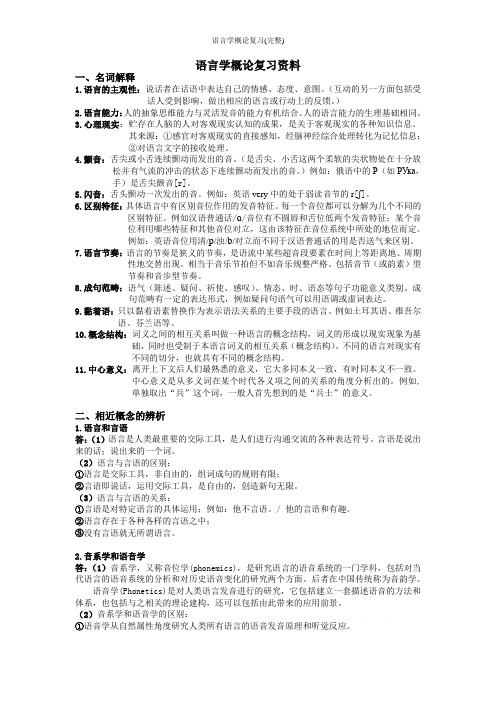
语言学概论复习资料一、名词解释1.语言的主观性:说话者在话语中表达自己的情感、态度、意图。
(互动的另一方面包括受话人受到影响,做出相应的语言或行动上的反馈。
)2.语言能力:人的抽象思维能力与灵活发音的能力有机结合。
人的语言能力的生理基础相同。
3.心理现实:贮存在人脑的人对客观现实认知的成果,是关于客观现实的各种知识信息。
其来源:①感官对客观现实的直接感知,经脑神经综合处理转化为记忆信息;②对语言文字的接收处理。
4.颤音:舌尖或小舌连续颤动而发出的音。
(是舌尖、小舌这两个柔软的尖状物处在十分放松并有气流的冲击的状态下连续颤动而发出的音。
)例如:俄语中的Р(如РУка,手)是舌尖颤音[r]。
5.闪音:舌头颤动一次发出的音。
例如:英语very中的处于弱读音节的r[ʃ]。
6.区别特征:具体语言中有区别音位作用的发音特征。
每一个音位都可以分解为几个不同的区别特征。
例如汉语普通话/ɑ/音位有不圆唇和舌位低两个发音特征;某个音位利用哪些特征和其他音位对立,这由该特征在音位系统中所处的地位而定。
例如:英语音位用清/p/浊/b/对立而不同于汉语普通话的用是否送气来区别。
7.语言节奏:语言的节奏是狭义的节奏,是语流中某些超音段要素在时间上等距离地、周期性地交替出现。
相当于音乐节拍但不如音乐规整严格。
包括音节(或韵素)型节奏和音步型节奏。
8.成句范畴:语气(陈述、疑问、祈使、感叹)、情态、时、语态等句子功能意义类别。
成句范畴有一定的表达形式,例如疑问句语气可以用语调或虚词表达。
9.黏着语:只以黏着语素替换作为表示语法关系的主要手段的语言。
例如土耳其语、维吾尔语、芬兰语等。
10.概念结构:词义之间的相互关系叫做一种语言的概念结构,词义的形成以现实现象为基础,同时也受制于本语言词义的相互关系(概念结构)。
不同的语言对现实有不同的切分,也就具有不同的概念结构。
11.中心意义:离开上下文后人们最熟悉的意义,它大多同本义一致,有时同本义不一致。
语言学概论复习资料(全)
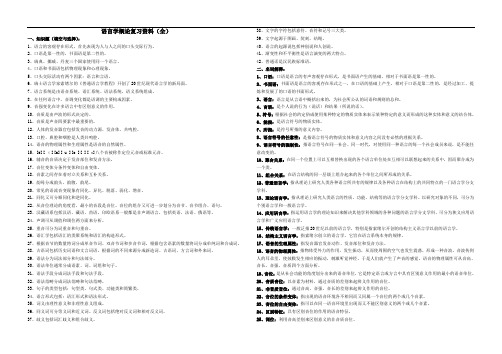
语言学概论复习资料(全)一、知识题(填空与选择):1、语言的客观存在形式,首先表现为人与人之间的口头交际行为。
2、口语是第一性的,书面语是第二性的。
3、瑞典、挪威、丹麦三个国家使用同一个语言。
4、口语和书面语包括物理现象和心理现象。
5、口头交际活动有两个因素:语言和言语。
6、瑞士语言学家索绪尔的《普通语言学教程》开创了20世纪现代语言学的新局面。
7、语言系统是由语音系统、语汇系统、语法系统、语义系统组成。
8、在任何语言中,音调变化都是语调的主要构成因素。
9、音强变化在许多语言中有区别意义的作用。
10、音质是由声波的形式决定的。
11、音质是声音四要素中最重要的。
12、人体的发音器官包括发音的动力源、发音体、共鸣腔。
13、口腔、鼻腔和咽腔是人类共鸣腔。
14、语音的物理属性和生理属性是语音的自然属性。
15、[e][ ε][a][ u ][o ][ ][ ɑ]八个音被称作定位元音或标准元音。
16、辅音的音质决定于发音部位和发音方法。
17、音位变体分条件变体和自由变体。
18、音素之间存在着对立关系和互补关系。
19、韵母分成韵头、韵腹、韵尾。
20、常见的语流音变现象有同化、异化、脱落、弱化、增音。
21、同化又可分顺同化和逆同化。
22、从音位理论的角度看,最小的音段是音位。
音位的组合又可进一步划分为音节、音节组合、语句。
23、汉藏语系包括汉语、藏语、苗语。
印欧语系一般都是非声调语言,包括英语、法语、俄语等。
24、声调可从调值和调位两方面来分析。
25、重音可分为词重音和句重音。
26、语汇学包括语汇的类聚系统和语汇的构造形式。
27、根据音节的数量将词分成单音节词、双音节词和多音节词。
根据包含语素的数量将词分成单纯词和合成词。
28、古语词包括历史词语和文言词语。
根据词的不同来源分成新造词、古语词、方言词和外来词。
29、语法分为词法部分和句法部分。
30、语法单位通常分成语素、词、词组和句子。
31、语法手段分成词法手段和句法手段。
语言学概论复习资料

1现代汉民族共同语(普通话):以北京语音为标准音,以北方话为基础方言,以典范的现代白话文著作为语法规范的普通话。
2现代汉语:是现代汉民族所使用的语言。
既有多种方言,也有民族共同语。
3方言特点:本身也有一种完整的系统。
语音,词汇,语法结构系统。
语音的差异最大,词汇的差异次之,语法比较小。
4汉语地位:1.世界上历史悠久的,发展水平最高的语言之一。
2.各兄弟民族的语言接受了汉语的许多影响。
3.世界上使用人数最多的语言。
4.与国外许多民族的语言相互影响。
5.联合国六种正式工作语言之一。
5语素——词——短语——句子(手)人(有读音,有意义,最小的语素)(沙发)(无法拆后原来意义不变)(伟)(无法单独成词)6现代汉语的特点:(一)语音方面①没有复辅音②元音占优势③有声调(二)词汇方面①汉语词形较短,单音节语素多②双音节词占优势③新词的构成广泛运用词根复合法(三)语法方面①汉语表示语法意义的手段主要用语序和虚词,不大用形态②词、短语和句子的结构原则基本一致③词类和句法成分关系复杂④量词和语气词十分丰富7七大方言区:1.北方方言(现代汉民族共同语的基础方言,以北京话为代表,内部一致性较强,分布地域最广,使用人口占73%)。
包含有华北东北方言和西北方言、西南方言、江淮方言2.吴方言(苏州话。
占7.2%)包括上海、江苏省大部、浙江大部地区3.湘方言(长沙话,3.2%)。
包括湖南大部分地区4.赣方言(南昌话,3.3%)。
江西省大部分地区5.客家方言(广东梅县话,客家方言仍自成系统,内部差别不太大,3.6%)。
6.闽方言(最重要的是闽东方言,福州话。
闽南方言,厦门话。
5.7%)。
主要包括福建和海南大部分地区7.粤方言(广州话。
4%)。
8语音的性质:一、语音的物理属性。
语音四要素:1.音高:声音的高低,决定于发音体颤动的快慢。
2.音强:声音的强弱,决定于发音体颤动幅度的大小。
3.音长:声音的长短,决定于发音体颤动的时间的久暂。
语言学概论复习
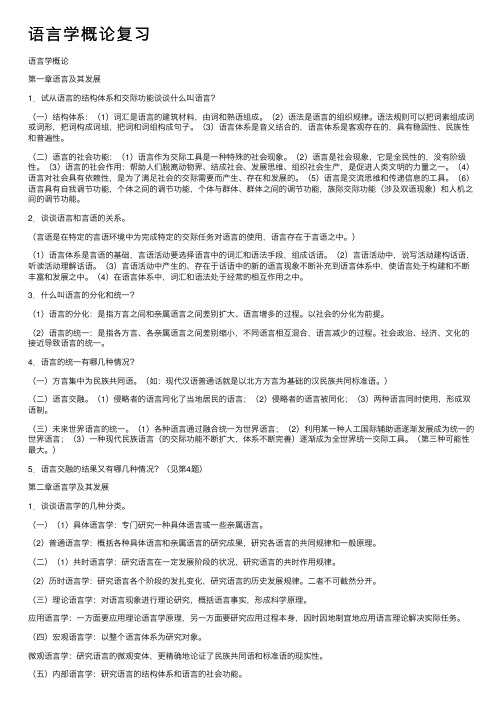
语⾔学概论复习语⾔学概论第⼀章语⾔及其发展1.试从语⾔的结构体系和交际功能谈谈什么叫语⾔?(⼀)结构体系:(1)词汇是语⾔的建筑材料,由词和熟语组成。
(2)语法是语⾔的组织规律。
语法规则可以把词素组成词或词形,把词构成词组,把词和词组构成句⼦。
(3)语⾔体系是⾳义结合的,语⾔体系是客观存在的,具有稳固性、民族性和普遍性。
(⼆)语⾔的社会功能:(1)语⾔作为交际⼯具是⼀种特殊的社会现象。
(2)语⾔是社会现象,它是全民性的,没有阶级性。
(3)语⾔的社会作⽤:帮助⼈们脱离动物界、结成社会、发展思维、组织社会⽣产,是促进⼈类⽂明的⼒量之⼀。
(4)语⾔对社会具有依赖性,是为了满⾜社会的交际需要⽽产⽣、存在和发展的。
(5)语⾔是交流思维和传递信息的⼯具。
(6)语⾔具有⾃我调节功能,个体之间的调节功能,个体与群体、群体之间的调节功能,族际交际功能(涉及双语现象)和⼈机之间的调节功能。
2.谈谈语⾔和⾔语的关系。
(⾔语是在特定的⾔语环境中为完成特定的交际任务对语⾔的使⽤,语⾔存在于⾔语之中。
)(1)语⾔体系是⾔语的基础,⾔语活动要选择语⾔中的词汇和语法⼿段,组成话语。
(2)⾔语活动中,说写活动建构话语,听读活动理解话语。
(3)⾔语活动中产⽣的、存在于话语中的新的语⾔现象不断补充到语⾔体系中,使语⾔处于构建和不断丰富和发展之中。
(4)在语⾔体系中,词汇和语法处于经常的相互作⽤之中。
3.什么叫语⾔的分化和统⼀?(1)语⾔的分化:是指⽅⾔之间和亲属语⾔之间差别扩⼤、语⾔增多的过程。
以社会的分化为前提。
(2)语⾔的统⼀:是指各⽅⾔、各亲属语⾔之间差别缩⼩,不同语⾔相互混合,语⾔减少的过程。
社会政治、经济、⽂化的接近导致语⾔的统⼀。
4.语⾔的统⼀有哪⼏种情况?(⼀)⽅⾔集中为民族共同语。
(如:现代汉语普通话就是以北⽅⽅⾔为基础的汉民族共同标准语。
)(⼆)语⾔交融。
(1)侵略者的语⾔同化了当地居民的语⾔;(2)侵略者的语⾔被同化;(3)两种语⾔同时使⽤,形成双语制。
语言学概论复习资料

语言的性质:语言具有符号性(任意性、稳固性、渐变性、线条型)、系统性、社会性、民族性、生成性、模糊性。
语言与言语:语言:广义的语言包括语言系统、言语活动和言语作品,狭义的语言只指语言系统。
言语则包括言语活动和言语作品。
语言与言语的区别:语言是抽象的、社会的、现成的、有限的、稳定的,言语是具体的、个人的、临时的、有限的、多变的。
语言与言语的联系:语言来自于言语,依存于言语;语言又制约着言语指导人们进行言语实践。
语言的包括口语与书面语两种表现形式。
口语是以语音为载体的语言形式,书面语是以文字为载体的语言形式。
书面语是在口语的基础上产生的,即口语是第一性,书面语是第二性。
口语比较灵活易变,而书面语比较保守稳固。
自然语言与人工语言:自然语言是由社会群体在日常交际活动中自然形成的语言,如汉语英语等。
人工语言是个别人人工设计出来的语言。
自然语言与人工语言除了社会性与个人性、自然性与人工性的区别外,自然语言具有民族性,人工语言具有国际性。
自然语言充满模糊性、多义性,人工语言一般比较明确没有歧义。
自然语言由全体社会成员使用,人工语言一般限于特定的范围使用。
自然语言可以作为母语自然学会,人工语言则不可以,自然语言有丰富的变体。
世界语就是一种典型的人工语言,在19世纪末由波兰医生柴门霍夫提出,世界语以印欧语系的语言为基础。
语言结构:语言系统可以划分为语音、语义、语汇语法是个子系统。
语言系统的符号与符号之间的复杂关系可以高度概括为组合关系与聚合关系两种基本关系。
语言的层级:语言层级系统的下层是语言符号的形式层,即语音层。
语音层包括音位和音节两个级别的语音单位。
音位的上一级语音单位是音节,一个音节由一个或几个音位构成。
音节是人们能自然感知的最小语音单位。
语言层级系统的上层是语音和语义结合的符号和符号组合层,上层包括三个级别的基本语言单位:语素、词、句子。
语言层级的特点:1、从语言的下层到上层有一个质的变化;2、从下一级语言单位到上一级都有量的扩充。
语言学概论复习资料
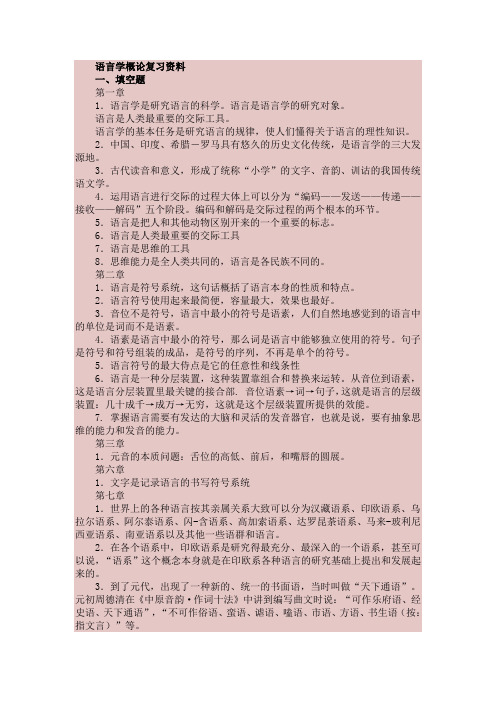
语言学概论复习资料一、填空题第一章1.语言学是研究语言的科学。
语言是语言学的研究对象。
语言是人类最重要的交际工具。
语言学的基本任务是研究语言的规律,使人们懂得关于语言的理性知识。
2.中国、印度、希腊-罗马具有悠久的历史文化传统,是语言学的三大发源地。
3.古代读音和意义,形成了统称“小学”的文字、音韵、训诂的我国传统语文学。
4.运用语言进行交际的过程大体上可以分为“编码——发送——传递——接收——解码”五个阶段。
编码和解码是交际过程的两个根本的环节。
5.语言是把人和其他动物区别开来的一个重要的标志。
6.语言是人类最重要的交际工具7.语言是思维的工具8.思维能力是全人类共同的,语言是各民族不同的。
第二章1.语言是符号系统,这句话概括了语言本身的性质和特点。
2.语言符号使用起来最简便,容量最大,效果也最好。
3.音位不是符号,语言中最小的符号是语素,人们自然地感觉到的语言中的单位是词而不是语素。
4.语素是语言中最小的符号,那么词是语言中能够独立使用的符号。
句子是符号和符号组装的成品,是符号的序列,不再是单个的符号。
5.语言符号的最大侍点是它的任意性和线条性6.语言是一种分层装置,这种装置靠组合和替换来运转。
从音位到语素,这是语言分层装置里最关键的接合部. 音位语素→词→句子,这就是语言的层级装置:几十成千→成万→无穷,这就是这个层级装置所提供的效能。
7. 掌握语言需要有发达的大脑和灵活的发音器官,也就是说,要有抽象思维的能力和发音的能力。
第三章1.元音的本质问题:舌位的高低、前后,和嘴唇的圆展。
第六章1.文字是记录语言的书写符号系统第七章1.世界上的各种语言按其亲属关系大致可以分为汉藏语系、印欧语系、乌拉尔语系、阿尔泰语系、闪-含语系、高加索语系、达罗昆荼语系、马来-玻利尼西亚语系、南亚语系以及其他一些语群和语言。
2.在各个语系中,印欧语系是研究得最充分、最深入的一个语系,甚至可以说,“语系”这个概念本身就是在印欧系各种语言的研究基础上提出和发展起来的。
语言学概论

语言学概论复习资料1.研究语言的结构,主要是研究(语音、词汇和语义、语法)三个部分。
2.语言的底层是一套音位,上层是符号和符号的序列,可以分为若干级,第一级和第二级分别是(语素、词),第三级是由词构成的句子。
3.从意义和作用看,词可以分为(实词和虚词)两大类。
4.“留心、老鼠、impossible”都是合成词5.“上帝”、“天堂”、“妖怪”、“神仙”等词的词义是(对现实现象的歪曲反映)。
6.语言符号的任意性特点说明了(语言是一种特有的社会现象)。
7.语言成分按线性次序组合起来所形成的关系是(组合关系)。
8.汉语的普通话,以北京语音为标准音,以北方话为基础方言,以(典范的现代白话文著作)为语法规范。
1.从自然属性角度划分出来的最小语音单位是(音素)。
2.汉语拼音方案是以(拉丁)字母为基础制订的。
3.汉语拼音中的û、c、h,国际音标分别写作(y ts‘x)。
4.下列说法,(音高具有区别意义的作用。
)是正确的。
5.下列说法,只有(频率越多,声音就越高。
)正确。
6.对发音器官功能的描述,(舌头的活动,起了调节共鸣器形状的作用。
)是正确的。
7.关于元音和辅音的区别的描述,(发辅音气流受阻,发元音气流不受阻。
)是正确的。
8.下列汉语拼音和国际音标对应正确的一组是(h-[x])。
9.下列发音方法完全相同的一组辅音是([t]-[k])。
10.下列各组元音区别的描述,(i和y的区别是舌位前后不同)是错误的。
12.下列说法,(音位具有区别意义的作用)是正确的。
13.我们在念“老虎”时,通常要把“老”念成阳平,这种变化叫做(异化)。
1.语法的聚合规则是潜在的2.(词)在语言中处于枢纽地位,一般把作为分析语法结构的最重要的语法单位。
3.对英语单词“workers”的分析,(Work和er都是构词语素)是正确的。
4.全都属于复合词的一组是(国家月球railway)5.“留心、伤心、老鼠、impossible”都是合成词6.全都属于述宾结构的一组是(看电影种庄稼to play football)。
语言学概论复习资料

语言学概论复习资料填空:1、动物与人类语言的区别:人具有抽象思维和灵活发音2、文字的定义:语言的视觉符号体系。
3、语言的谱系分类:(汉藏、阿尔泰、南岛、南亚、印欧)语系,汉语属于汉藏语系,英语属于印欧语系。
4、词类的划分标准:形态标准意义标准句法标准5、结构主义语言学家索绪尔6、在信息传递中, 人类语言最重要。
7、语法范畴方面:词形变化8、社会方言的情况:阶层语、行业语、隐语、黑话9、语言演变以音位为单位。
10、语言的发展主要体现在(语言的分化与统一)、(语言的接触与融合)等方面。
判断正误1、地域方言的定义:地域方言是一种语言在不同地域所形成的变体。
地域方言是全民语言在不同地域的分支,是语言发展不平衡性在地域上的反映。
元音是指呼出气流不受口腔部位阻碍而发出的音。
决定元音音质的三个方面:舌位的高低;舌位的前后;嘴唇的圆展。
辅音是指呼出气流受口腔部位阻碍而发出的音。
决定辅音音质的因素:一是是发音部位,二是发音方法。
2、语言符号的性质:语言是符号系统。
符号,就是一种人们通过视觉或听觉等能够感知到的对象,并把这种对象与某种事物相联结,从而使得一定的对象代表一定的意义。
符号分三种:一是视觉符号,二是听觉符号,三是触觉符号。
(p21)4、组合关系和聚合关系:组合关系,符号和符号按照一定规则组合起来的关系就是语言的组合关系。
聚合关系专指那些具有替换关系的语言单位之间的关系。
语言的组合关系和聚合关系是语言的两种根本关系,是语言系统的纲,把握了这个纲,就基本上把握了语言系统。
名词解释:1、同化:语流中两个邻近的不同的音,其中一个受到另一个的影响而变得跟它相同或相近,叫同化。
2、浊音轻化:“清——浊”是中古汉语的一对区别特征,后来浊音这个区别特征在很多方言中消失了,原来的浊音与同部位、同方法的清音合并。
这种现象叫做“浊音清化”。
3、符号:一个社会全体成员共同约定用来表示某种意义的记号、标记。
它包括了形式和意义两个方面的要素,是一定的形式和一定的内容的统一体,二者缺一不可。
- 1、下载文档前请自行甄别文档内容的完整性,平台不提供额外的编辑、内容补充、找答案等附加服务。
- 2、"仅部分预览"的文档,不可在线预览部分如存在完整性等问题,可反馈申请退款(可完整预览的文档不适用该条件!)。
- 3、如文档侵犯您的权益,请联系客服反馈,我们会尽快为您处理(人工客服工作时间:9:00-18:30)。
1. What are the categories of lexical meaning?Lexical meaning includes: a) referential meaning (also denotative meaning). b) Associative meanings. Referential meaning is the central meaning and it is more stable and universal. Associative meanings are meanings are meanings that hinge on referential meaning, which are less stable and more culture-specific.Types of associative meanings: connotative meaning, social meaning, affective meaning, reflected meaning, collective meaning2. What are the components of metaphor?There are two positions on the function of metaphors: a) the classical view sees metaphor a rhetorical device; b) another view holds metaphor a cognitive device. Metaphors 一s possible precisely because there are metaphors in a person’s concep tual systems.All metaphors are composed of two domains: target domain (also tenor) and source domain (vehicle).3. How does transformational grammar account for sentence- relatedness?1) According to Chomsky, a grammar as the tacit shared knowledge of all speakers is a system of finite rules by which an infinite number of sentences can be generated. He attempts to account for this aspect of syntax by postulating that deep structures and surface structures.2) Deep structures are the basic structures generated by phrase structure rules.3) Surface structures are derived structures, the structures of sentences that we actually speak. Surface structures are derived from deep structures through transformational rules which include replacement, insertion, deletion and coping, etc.4. On what basis do linguists regard human language as species-specific (unique to humans)?Language is a system of arbitrary vocal symbols used for human communication. Many philosophers and linguists believe that language is unique to man. Language is a human trait that sets us apart from other living creatures. They spell out a number of features of language which are not found in animal communication systems. These features: creativity, duality, arbitrariness, displacement, cultural transmission, interchangeability and reflexivity. These are universal features possessed by all human languages. Although some animal communication systems possess, to a very limited degree, one or another of these features except creativity and duality, none is found to have all the features. On this basis linguists tend to conclude that human languages are qualitatively differentform animal communication systems.5. What part of syntax can phrase structure rules account for and what they cannot?Phrase structure rules are rules that specify the constituents of syntactic categories. These rules are part of speakers’ syntactic knowledge, which govern the construction of sentences.There are a lot of part of syntactic knowledge, including structural ambiguity (which strings of words have more than one meaning), words order (different arrangements of the same words have different meanings), grammatical relations (what element relates to what other element directly or indirectly), recursion (the repeated use of the same rules to create infinite sentences), sentence relatedness (sentences may be structurally variant but semantically related), and syntactic categories (a class of words or phrases that can substitute for one another without loss of grammaticality) etc. Phrase structure rules can account for structural ambiguity, word order, grammatical relations, recursion, and syntactic categories; but they cannot account for sentence relatedness.6. How do sociolinguists classify the varieties of English?The term variety is the label given to the form of a language used by any group of speakers or used in a particular field. A variety is characterized by the basic lexicon, phonology, syntax shared by members of the group. Varieties of a language are of four types: the standard variety, regional dialects, sociolects and registers.A regional dialect is a variety of a language spoken by people living in an area. The English language has many regional dialects. British English, American English, Australian English. Indian English, South African English, etc. are all regional varieties of the language. One dialect is distinctive from another phonologically, lexically and grammatically.7. What are the functions of supra-segmental features?The phonetic features, distinctive or non-distinctive, that we have discussed so far may be properties of single segments. In this section we will look at features that are found over a segment or sequence of two or more segments, which are called suprasegmental features. These features are also distinctive features. They are found in such units of syllables, words, phrases and sentences. The most widely found suprasegmental features are stress, intonation and tone.Stress is defined as the perceived prominence (comparative loudness) of one or more syllable elements over others in a word. This definition implies that stress is a relative notion. Intonation: when we speak, we change the pitch of our voice to express ideas. The same sentence utteredwith different intonation may express different attitude of the speaker. In English, there are three basic intonation patterns: fall, rise and fall-rise. Tone is the variation of pitch at the word level to distinguish words. The same sequence of segments can be different words if uttered with different tones. English is not a tone language. Chinese is a typical tone language.Intonation and stress generally occur simultaneously in utterance. When intonation contour falls on a syllable, the nucleus is stressed and the vowel is naturally lengthened a bit. In the meantime, there is a little pause after the syllable. This simultaneous functioning of the features serves to highlight the information focus, or to eliminate ambiguity (double interpretations of the same phrase or sentence).8. What are aspects of syntactic knowledge?Syntactic knowledge is the knowing of which strings of words are grammatical and which are not. In addition, it includes: 1) structural ambiguity 2) word order 3) grammatical relations 4) recursion 5) sentence relatedness 6) syntactic categories.9. The advantages and disadvantages of componential analysis?1st, it is a breakthrough in the formal representation of meaning. Once formally represented, meaning components can be seen. 2nd, it reveals the impreciseness of the terminology in the traditional approach to meaning analysis. Looking at the semantic formula of man and woman again you can see that it is not true that the total meaning of one word contrasts with that of the other. It is merely in one semantic feature that the two words contrast. When we look at the semantic formulae of man and father, we find that all the semantic features of man are included in the semantic formula of father. Then we reach a different conclusion from common sense in regard to the relation between man and father. Is this contradictory? The answer is No. The obvious fact that man includes father is derived from the perspective of reference. Componential analysis examines the components of sense. The more semantic features a word has, the narrower its reference it is.The limitations of componential analysis are also apparent. It cannot be applied to the analysis of all lexicon, merely to words within the same semantic field. It is controversial whether semantic features are universal primes of word meanings in all language. Nevertheless, CA is so far a most influential approach in the structural analysis of lexical meaning.10. How do sociolinguists classify the varieties of English?A variety of a language are of 4 types, the standard variety, regional (geographical) dialects, sociolects(social dialects) andregisters( functional varieties). The standard variety is the form of a language used by the government and communication media, taught in schools and universities and is the main or only written form. The standard variety is used most widely in a community. It is more fixed than other varieties, allowing less variation in pronunciation, spelling/writing and grammar. A regional dialect is a variety of a language spoken by people living in an area. This kind of language variation is most noticeable. When we travel throughout a wide geographical area where the same language is spoken, we are sure to notice difference in pronunciation, in the choices and forms of words, and even in syntax. Sociolects are forms of a language that characterize the speech of different social classed. This correlation between language and socio-economic status is often referred to as social stratification of language. While some sociolinguists focus on socio-economic status as a correlate, others look at gender as a factor for social variation of language. Register is a term widely used in sociolinguistics to refer to varieties according to use, in contrast with regional dialects and sociolects, both of which are varieties according to user. Register as a variety of language in use, is analyzed on 3 dimensions: field, mode and tenor. Field is concerned with the purpose and subject-matter of communication. Mode refers to the means by which communication takes place, through speech or writing. Tenor depends on the relations between the participants.11. Why is linguistics a vast field of study?Linguistics is a broad field of study, because language is a complicated entity with many layers and facets. There are a number of divisions of linguistics, which can be put into two categories. 1) Intra-disciplinary divisions: the study of language in general is often termed general linguistics. It is based on the view that language as a system is composed of three aspects: sound, structure and meaning. 2) Inter-disciplinary divisions a) Sociology deals with language and culture. b) Psycholinguistics deals with the relation between language and mind c) applied linguistics is concerned with the application of linguistic theories and descriptions in other fields. All above three belong to sociolinguistics.12. How is linguistics different from traditional grammar?1) Traditional grammar is prescriptive and modern linguistics is descriptive.2) Traditional grammatical categories are merely based on European language but linguistic studies all languages.3) Traditional grammar lacks a theoretical framework, while modern linguistics is theoretically rather than pedagogically oriented.13. How are speech sounds described?The study of speech sounds is phonetics which includes 3 parts: 1) articulatory phonetics 2) acoustic phonetics 3) auditory phonetics. Articulatory phonetics is the primary concern in linguistics, in which speech sound is described within 3 sides:The description of consonants: a) place of articulation b) manners of articulation c) voicing d) aspirationThe description of vowels: a) monophthongs b) diphthongs c) lip rounding d) tensity14. Difference between linguistic competence and communicative competence1) Linguists like Chomsky who are not concerned with language use propose the term linguistic competence to account for a speaker’s knowledge of his or her language.2) Sociolinguists like Dell Hymes propose communicative competence as the most general term to account for both the tacit knowledge of language and the ability to use it. According to Hymes, there are 4 parameters that underlie a speaker’s communicative competence, namely the ability to judge: a) whether sth is possible. b) feasible c) appropriate 4) done.15. How are words decomposed into their constituents1) Words are composed of one or more than one morphemes.2) Morphemes are the smallest meaningful unit of language.3) Morphemes can be categorized into 2 kinds. a) free morphemes( they constitute words by themselves) b) bound morphemes( they are never used independently)4) Bound morphemes include inflectional morphemes and derivational morphemes.16. What are aspects of syntactic knowledge?Syntactic knowledge is the knowing of which strings of words are grammatical and which are not. In addition, it includes: 1) structural ambiguity 2) word order 3) grammatical relations 4) recursion 5) sentence relatedness 6) syntactic categories.17. What are the two classes of phonetic features? What is the fundamental difference?The two classes of phonetic features are distinctive features and non-distinctive features. Features that distinguish meaning are called distinctive features, in other words, those distinguishing phonemes. Non-distinctive features do not distinguish meanings, i.e. the features belong to allophones. However, whether a phonetic feature is distinctiveor non-distinctive varies from one language to another language.18. How do you account for the relation between phonetics and phonology?Phonology and phonetics are both concerned with the study of speech sounds, but the two differ in perspectives. Phonetics, particularly articulatory phonetics, focuses on how speech sounds are produced, what phonetic features they have, and how to transcribe them. In phonetics, sound segments are assumed to be invariable; variations are overlooked. Phonology focuses on three fundamental questions. What sounds make up the list of sounds that can distinguish meaning in a particular language? What sounds vary in what ways in what context? What sounds can appear together in a sequence in a particular language?19. What are the components of communicative competence?According to Hedge, there are mainly five components of communicative competence. They are linguistic competence, pragmatic competence, discourse competence, strategic competence, and fluency.1. Analyze the sentence in terms of type of process, mood structure, and theme and rheme:The academician will address the issue of the legitimacy of cloning at the conference.It is the verbal process. In this sentence, the sayer is the academician, the receivers are the people at the conference though it is not mentioned but we can infer it from the sentence. The verbiage is the issue of the legitimacy of cloning.This sentence is the realization of linguistic interaction, it is the giving of information. Its syntactic form is statement. The subject is the academician, the finite is the verbal operator “will”.The constituent that stands for the starting-point for the message is termed theme; all the rest of the sentence is labeled rheme. In this sentence, the theme is the academician and “the issue of the legitimacy of cloning at the conference” is the rheme.2. Analyze the two English sound segments【K】and 【Kh】in terms of distribution and the phonetic feature that distinguish them.1) Both are in complementary distribution. They are the allophones of the phoneme【K】.【K】: fricative, voiceless, alveolar.【Kh】: elsewhere2) the phonetic feature that distinguish them is aspirationWhat are aspects of syntactic knowledge?Syntactic knowledge is the knowing of which strings of words are grammatical and which are not. In addition, it includes: 1) structural ambiguity 2) word order 3) grammatical relations 4) recursion 5) sentence relatedness 6) syntactic categories.3. Point out the semantic problem of the sentence "the orphan is staying with his parentsThere are some sentences which sound grammatical but meaningless. The sentence "the orphan is staying with his parents” is just one example. This sentence is always false which is called contradiction. An orphan is a child whose parents are dead, or a child who has been deprived of parental care. The theme (the orphan) and the rheme (is staying with his parents) are incompatible.4.Analyze the change of feature concerning the liquids and nasals in flight, snow, smart, pray and generalize the rule.Liquids /l/ /r/ appear after a voiceless consonant /f/ and /p/ respectively, they are devoiced.Nasals /n//m/ appear after a voiceless consonant /s/, they are devoiced. Rule: Devoice a voiced consonant after a voiceless consonant.Or: When the English liquids, glides and the two anterior nasals appear after a voiceless consonant, it is devoiced. This rule can be expressed as follows: devoice a voiced consonant after a voiceless consonant,that is, [+voiced+consonantal] [-voiced] / [-voiced+consonantal]-. The phonology /l/ /r/ belong to liquids, and /m/ /n/ belong to anterior nasals. All these four are voiced consonant, but in these words, they change to the voiceless, for they appear after voiceless consonants.5. Analyze the semantic properties of the given cooking terms, using the features<+/-LIQUID>,<+/-FAT>,<+/-OVEN>,<+/-SIEVE>,ect.boil +liquid,-fat,-oven,-sieve6. Analyze the cooking term stew as a verb by way of componential analysis and mark the feature that you think is distinguisher.Stew [+water][+pot ][ ][ ]stew: +cook +hot +close dish +juice (+ juice: semantic distinguisher)7. Analyze the cause of the error that some Chinese speakers of English use although and but within one sentence.In the process of analyzing learners' language, error analysis is a milestone. Explaining errors is the final but very important step in erroranalysis. In terms of sources, errors are divided into interlingual errors and intralingual errors. Interlingual errors are caused by mother tongue interference which means the negative role one's knowledge of L1 to L2 learning. In Chinese, we can use “不但”,“而且”in the same sentence, so some Chinese speakers transfer this expression directly to English. But according t o English grammar, “although” and “but” can not appear in the same sentence. This phenomenon is a kind of negative transfer of learners' syntactic knowledge. This is a typical phenomenon of interference in learning.8. Analyze the sentence in terms of type of process, mood structure, and theme and rheme:The academician will address the issue of the legitimacy of cloning at the conference.It is the verbal process. In this sentence, the sayer is the academician, the receivers are the people at the conference though it is not mentioned but we can infer it from the sentence. The verbiage is the issue of the legitimacy of cloning.This sentence is the realization of linguistic interaction, it is the giving of information. Its syntactic form is statement. The subject is the academician, the finite is the verbal operator “will”.The constituent that stands for the starting-point for the message is termed theme; all the rest of the sentence is labeled rheme. In this sentence, the theme is the academician and “the issue of the legitimacy of cloning at the conference” is the rheme.9. Analyze the semantic properties of the given cooking terms, using the features [+/- W ATER], [+/-FAT], [+/- PAN], [+/- POT], [+/- OVEN], [+/- SIEVE], etc.boil: [+W ATER] [-FAT] [- PAN] [+ POT] [- OVEN] [- SIEVE]fry: [- W ATER] [+FAT] [+ PAN] [- POT], [- OVEN] [+SIEVE] steam: [+W ATER] [-FAT] [- PAN] [+POT] [-OVEN] [- SIEVE]stew: [+W ATER] [+FAT] [- PAN] [+ POT] [- OVEN] [- SIEVE]bake: [- W ATER] [+FAT] [- PAN] [- POT] [+ OVEN] [- SIEVE]10. Write the type of reference of it in each of the following sentences:(1) It is rather foggy these days.(2) It is so far hard to tell how many lives are claimed in the catastrophe..(3) The most powerful earthquake triggered massive tidal waves that slammed into coastlines across Asia yesterday. It killed over 30,000 people in Sri Lanka, Indonesia, India, Thailand, Malaysia, Myanmar, Bangladesh and Maldives.(1) “It” here refers to the weather. It is an exphoric reference, referring tothe world outside linguistic forms.(2) “It” refers to the following expression, “how man lives are claimed in the catastrophe”, which is a linguistic form.. Thus, it is an endophor ic reference, specifically, cataphoric reference (cataphora).(3) “It” refers to the preceding expression, that “massive tidal waves slammed into coastlines across Asia yesterday”. Therefore, it is an endophoric reference, specifically, anaphoric reference (anaphora).11. Analyze the ambiguity of the two sentences, telling the difference:(1)Flying planes can be dangerous.(2)She cannot bear children.1. a. The behavior of flying planes can be dangerous.b. Planes which is flying can be dangerous.2. a. She cannot endure children.b. She cannot give birth to children.。
